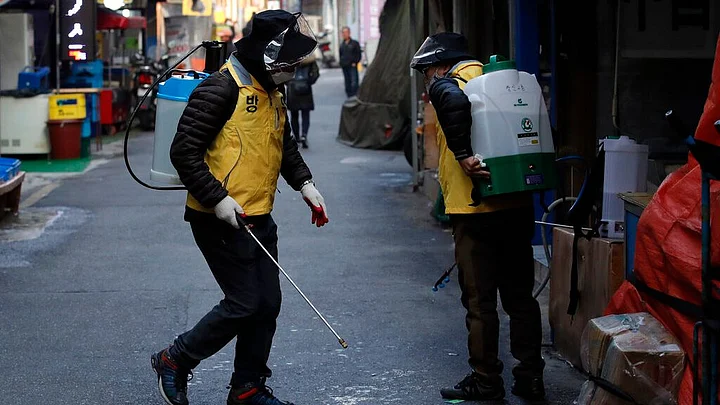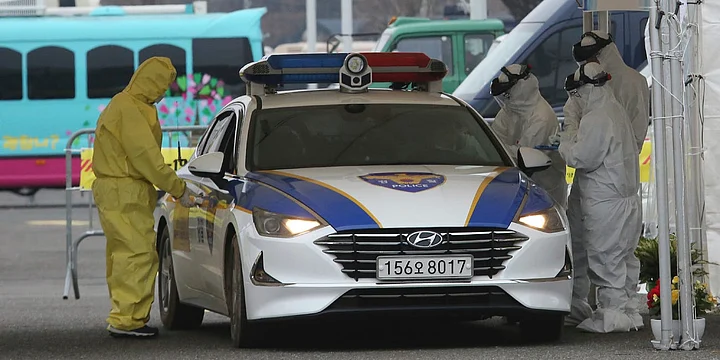A virus that had never been seen before December 2019, has managed to infect more than 218,824 and take more than 8,810 lives globally — all in a matter of three months.
Yes, the new strain of coronavirus has left the world struggling, confused but also determined. To that extent, countries are ramping up efforts and devising different strategies to ‘flatten the curve’ and minimise losses — with an objective to not overwhelm their healthcare systems.
Here, South Korea has stood out. The country’s COVID-19 death rate is less than one percent, compared to the world average of over 3 percent. This, after once being the hardest-hit country outside China. How did South Korea manage it?
The Rise, Peak, and Fall of COVID-19 Cases in South Korea

A look at the country’s trajectory will explain it all.
- Till mid-February, South Korea just had 30 confirmed cases of COVID-19. The 31st case, however, became the country’s ‘super-spreader’. ‘Case-31’, as the woman is referred to, had attended church services with over 500 other attendees at each congregation.
- The next 12 days saw the highest surge in cases in South Korea, with around 2900 more cases (most had attended the church services).
- On 29 February, over 900 new cases were registered. This made South Korea the country with the second-highest COVID-19 cases after China, where the disease first originated, with the number crossing 3000. Over 900 new cases were being diagnosed daily in the country.
- Subsequent outbreaks were reported from a psych ward and a call centre.
- But from the peak of 900 new cases daily, the country managed to come down to less than 100 every day.
The consistent decline in new cases was, however, interrupted with 152 new cases being reported by the Korea Centers for Disease Control and Prevention (KCDC) on Thursday, 19 March, after an outbreak in a nursing home in the city of Daegu.
But the fact remains: South Korea has managed to do what no other country has, without any severe lockdowns or travel restrictions. Let’s understand exactly how this happened.
Tests, Tests, and More Tests
South Korea has tested more than 270,000 people — almost 5200 tests per million of the population. Compare this to the US’ 74 tests per million.
Or look at India’s daily test numbers at 600 against South Korea’s 20,000. The country is clearly testing vigorously.
South Korea had started preparing for the outbreak long before the virus had even been reported in the country. According to an Al Jazeera article, at least four South Korean firms had begun to develop and stock test kits with the government just when China first released the virus’ genetic sequence in January. The country had approved the first test as early as on 7 February. When the outbreak actually happened, South Korea was at the stage and capability of testing more than 10,000 people daily.
On the other hand, India, even as it continues to see a consistent rise in its COVID-19 cases with each passing day, is still capable of testing only 6000 samples in its labs, as told by the Indian Council of Medical Research. This number will change once private labs get into the game.
Take a look at the population of both the countries, and just how dismal and desperate the state of affairs here could potentially be, would become apparent.
Developing testing kits is one. But making testing facilities available, convenient, and rapid is another milestone that South Korea seemed to have successfully accomplished. The country’s innovation of opening ‘drive-through’ clinics is being replicated by other countries, including the UK and the US. The entire testing process here takes not more than 10 minutes, with a brief questionnaire, temperature check and a nose-swab, as the patient sits inside the car. This also ensures that there is minimal contact with other potentially infected persons — a risk with walk-in clinics.

Moreover, the country has also installed mobile testing stations and consultation food booths at hospitals, along with starting home visits for testing, which can, in a matter of hours, give out the results.
South Korea has also managed to make use of technology in more ways than one. A GPS app tracks quarantined individuals and sets off an alarm if they move out. People entering the country are also required to record their symptoms on a state-sponsored app. In fact, all those who own cell phones regularly receive alerts about nearby areas that may be infected - so that they could avoid venturing out there.
Notably, South Korea had, in the initial stages itself, done away with the criterion that patients had to have traveled abroad in order to be tested — which is what India is still doing (along with contact tracing), claiming to still be in the ‘local transmission phase’.
Lessons From the Past
This time, the country was prepared.
But this came after the Middle East Respiratory Syndrome (MERS) outbreak that struck South Korea in 2015 and led to almost 40 deaths. While the outbreak subsided in two months due to aggressive quarantining, tracing and testing, the country had learned the importance of being on its toes and ready for the future.
Kim Woo-Joo, an infectious disease specialist at Korea University, was quoted by Science magazine, as saying,
It was during the MERS outbreak that the government enacted the legislation that today allowed it to collect phone and credit card data of those who had tested positive, in order to track their whereabouts — the information that is being used to alert others. Importantly, it does not reveal any personal identifiers.
The novel coronavirus encountered in Wuhan was a red flag for South Korea — which amped up its efforts to develop testing kits immediately after.
The Fight Is Still On
While the successes of the South Korean government have been widely acclaimed and appreciated across the world, there’s still time in declaring the country to be completely over the outbreak. With the latest number being reported from a nursing home crossing 100, it is clear that South Korea needs to continue with its rigorous measures and aggressive testing.
Moreover, the country has largely been focusing on the ‘clusters’ of the pandemic, without paying equal attention to other parts. The emergence of new clusters could be “the initiation of community spread”, Kim Woo-Joo told Science.
The coming months are crucial, for South Korea and the world.
(At The Quint, we are answerable only to our audience. Play an active role in shaping our journalism by becoming a member. Because the truth is worth it.)
